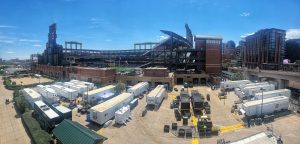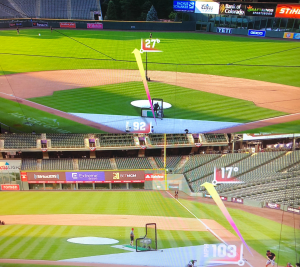MLB All-Star 2021 in Review: Fox Sports, ESPN, MLB Network Convene in Denver for Tech-Filled Baseball Showcase
Story Highlights
Major League Baseball’s All-Star Game is a meeting of fans from across the nation and continent, but also a conclave of the brightest minds in the sports-video-production industry. After the tumultuous year that was 2020, the 2021 edition at Denver’s Coors Field was a cathartic moment filled with excitement, jaw-dropping technology, and hard work. Here is a quick rundown of the efforts done by each of the three participating networks:
Fox Sports Unleashes Barrage of Tech for 91st MLB All-Star Game
Fox Sports was once again at the center of MLB’s crown jewel event with 65 cameras, including two Megalodons and two FlyCams, 4K HDR workflows, a loaded truck compound, and offsite resources from the Vault in Los Angeles. It wouldn’t be an MLB All-Star Game without a high dose of immersive audio, and the network installed more than 75 microphones down at field level, including 13 strategically placed in the grass and dirt.
“We have a lot of tentpole events, so it’s great to come back to a compound that’s very similar to what it looked like before the pandemic,” said SVP, Technical and Field Operations Mike Davies before the game. “We’ve certainly been able to take advantage of technology to make things more efficient, but if you look back at where we were when sports returned, any of us back in May 2020 would have felt really happy to be in an environment that we’re in right now.”
Click HERE for a full breakdown of Fox Sports production of the 2021 MLB All-Star Game.
 Fox Sports’ Francisco Contreras Runs Down Long List of Broadcast Technology
Fox Sports’ Francisco Contreras Runs Down Long List of Broadcast Technology
After an explosive Home Run Derby on Monday night, Fox Sports geared up for a fitting finale to the All-Star proceedings on Tuesday. Tasked with the main broadcast of the 2021 MLB All-Star Game, the broadcaster deployed a bevy of technology that highlighted the finer details and accentuate the atmosphere of baseball’s most grandiose exhibition contest.
Director, Field Operations Francisco Contreras explained the technological headliners in the 65-camera show, how 4K HDR workflows were developed leading up to this game, where both Megalodons were used throughout Coors Field, and his thoughts on returning to the Midsummer Classic after the cancellation of last year’s scheduled event.
Click HERE to watch the full interview.
 Fox Sports’ Tom Lynch Spotlights the Denver Compound
Fox Sports’ Tom Lynch Spotlights the Denver Compound
This year’s event marked the first time it was broadcasted in 4K HDR and featured a strong arsenal of 50 1080p HDR cameras, 75 microphones, advanced ball-tracking technology, and much more.
Fox Sports Lead Tech Producer Tom Lynch spoke with SVG about the layout of the compound outside Denver’s Coors Field and shares the thrill of being back onsite after such a long time away.
Click HERE to watch the full interview.
ESPN Taps Augmented Reality, Traditional Workflows for Electric Home Run Derby
ESPN showcased this year’s Statcast-driven alternative broadcast of the Home Run Derby with reimagined on-air elements and other real-time augmented-reality (AR) overlays on ESPN2. The network worked closely with Major League Baseball to develop an overlay that display an arrow pointing in the direction of the batter’s calculated launch angle and exit velocity at the bottom. As the ball traveled through the air and landed in the stands, the alternative broadcast showed a target with the ball’s accurate distance.
“Our alternative Statcast presentation offers us a great opportunity to test the [production] waters,” said Senior Coordinating Producer Phil Orlins before the event. “We’ve always differentiated our Home Run Derby coverage on ESPN2, but, this year, we’ll have a really aggressive plan to differentiate visual coverage of each at-bat with augmented reality.”
The broadcaster also highlighted its MLB Draft coverage with a remote production from the compound. For this remote production from the stadium’s compound, the broadcast tapped into the shared resources — nearly 50 remote feeds of players and team executives — of MLB Network.
Click HERE for a complete look at ESPN’s work done on the MLB Home Run Derby and MLB Draft.
ESPN’s Phil Orlins Highlights Home Run Derby Technology
Denver’s Coors Field is a power hitter’s heaven, and, for batted balls that flew all over the place during the 2021 MLB Home Run Derby, ESPN showcased this year’s Statcast-driven alternative broadcast with reimagined on-air elements and other real-time augmented-reality (AR) overlays on ESPN2.
ESPN Senior Coordinating Producer Phil Orlins chatted with SVG’s Kristian Hernandez about the efforts behind the scenes and what it’s like to be back at the ballpark.
Click HERE to watch the full interview.
ESPN’s Cindy Pennington Walks Through the Broadcast Compound at Coors Field
ESPN was back on site with a sizable presence in and around the ballpark. With a new take on the MLB Draft and the crown jewel that was the MLB Home Run Derby, this year’s operational strategy was tremendous.
ESPN Project Manager Cindy Pennington divulged the planning that went into this year’s event and how – with so many sports overlapping in this log-jammed year of sports – this was one of the most challenging projects she’s worked on.
Click HERE to watch the full interview
MLB Network Offers Robust Onsite Coverage of MLB Draft, All-Star Festivities
MLB Network celebrated the first-ever production of the MLB Draft during All-Star festivities within a packed onsite production truck, remote workflows from multiple control rooms at headquarters, and remote video feeds from individuals who enjoyed this noteworthy achievement away from Denver’s Bellco Theatre. BitFire Networks provide upwards of 50 remote camera feeds, including 15 prospects from their respective locations and general managers and other executives in the war rooms of all 30 clubs.
“We’ve been going on surveys every year for the past six to seven years in anticipation of one day doing this onsite,” said SVP, Operations and Engineering Susan Stone before the event. “We’re really thrilled that we can finally see the fruits of everybody’s labor and we think it’s a great opportunity to further showcase this event.”
Closer to Coors Field, MLB Network dove headfirst into the five-day-long festivities with expansive coverage of Monday’s Media Day and Tuesday’s Red Carpet Show. Centrally located at McGregor Square, a 659,000-sq.-ft. development that officially opened its doors to the public last month, the network constructed two stages and leveraged an ample, yet beautiful space just outside of the stadium.
“In terms of remote workflows to multiple onsite venues, this will be one of the largest remote [efforts] that we’ve collectively ever done,” said VP, Remote Operations Tom Guidice before the events. “Being able to see everyone and do this right out of the gate [after the initial start of the pandemic] is great.”
Click HERE for the network’s production of the MLB Draft and HERE for coverage.
CP Communications Handles Plethora of RF Needs
For the biggest events during the recent four-day stretch in Denver, CP Communications was onsite to assist all participating broadcasters with RF connectivity at a multitude of venues. CP’s solutions covered a large chunk of equipment used by Fox Sports, ESPN, and MLB Network. On the camera front, 16 RF handhelds included a Sony HDC-P50 on an MōVI camera rig, a SteadiCam, two Megalodons, two FlyCams, and batting cage POVs. As for audio, 60 wireless microphones included those used by reporters, players, umpires, and coaches and others that were placed in the ground.
“Given the size, shape, and number of users at an All-Star Game, coordination is extremely important,” said President Michael Mason. “In this region, mountain top TV transmitters made it more challenging, but doing accurate site surveys and getting current spectrum scans from the area were extremely critical.”
Click HERE to learn about all of CP Communications’ onsite work.







